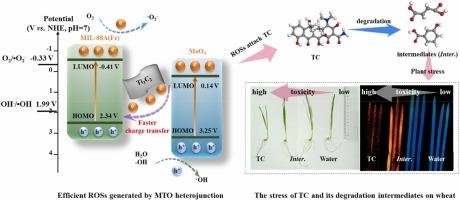Efficient photocatalytic degradation of antibiotics using Z-scheme MIL-88(Fe)/Ti3C2/MoO3: mechanistic insights and toxicity assessment
IF 11.3
1区 环境科学与生态学
Q1 ENGINEERING, ENVIRONMENTAL
引用次数: 0
Abstract
Antibiotic residues cause water contamination and disrupt aquatic ecosystems. Herein, we reported the fabrication of a novel Z-scheme heterojunction, MIL-88A(Fe)/Ti3C2/MoO3 (MTO), for safe and efficient removal of antibiotics. Ti3C2 was introduced into the MIL-88A(Fe)/MoO3 (MO) heterojunction as an electronic mediator to accelerate charge separation. Consequently, the ternary MTO achieved a tetracycline (TC) degradation rate 2.5 times higher than that of MO. Notably, the MTO heterojunction maintained high TC degradation efficiency over 36 consecutive hours without significant decline. Photogenerated holes, hydroxyl radicals, and superoxide radicals synergistically led to efficient and deep mineralization of TC. Furthermore, toxicity assessments were performed using Toxicity Estimation Software Tool (T.E.S.T.), bacteria (S. aureus and E. coli) cultivation, wheat germination and cultivation. The results all confirmed the safe degradation of TC. Therefore, this study provides a promising strategy for photocatalytic removal of antibiotics and promotes sustainable water purification technologies.

MIL-88(Fe)/Ti3C2/MoO3光催化降解抗生素的机理及毒性评价
抗生素残留造成水污染,破坏水生生态系统。在此,我们报道了一种新型的z型异质结MIL-88A(Fe)/Ti3C2/MoO3 (MTO)的制备,用于安全有效地去除抗生素。在MIL-88A(Fe)/MoO3 (MO)异质结中引入Ti3C2作为电子介质加速电荷分离。因此,三元MTO的四环素(TC)降解率比MO高2.5倍。值得注意的是,MTO异质结在连续36小时内保持了较高的TC降解效率,而没有明显下降。光生空穴、羟基自由基和超氧自由基协同作用导致TC高效、深度矿化。此外,采用毒性评估软件工具(T.E.S.T.)、细菌(金黄色葡萄球菌和大肠杆菌)培养、小麦萌发和培养进行毒性评估。结果均证实了TC的安全降解。因此,本研究为光催化去除抗生素提供了一种有前景的策略,并促进了可持续的水净化技术。
本文章由计算机程序翻译,如有差异,请以英文原文为准。
求助全文
约1分钟内获得全文
求助全文
来源期刊

Journal of Hazardous Materials
工程技术-工程:环境
CiteScore
25.40
自引率
5.90%
发文量
3059
审稿时长
58 days
期刊介绍:
The Journal of Hazardous Materials serves as a global platform for promoting cutting-edge research in the field of Environmental Science and Engineering. Our publication features a wide range of articles, including full-length research papers, review articles, and perspectives, with the aim of enhancing our understanding of the dangers and risks associated with various materials concerning public health and the environment. It is important to note that the term "environmental contaminants" refers specifically to substances that pose hazardous effects through contamination, while excluding those that do not have such impacts on the environment or human health. Moreover, we emphasize the distinction between wastes and hazardous materials in order to provide further clarity on the scope of the journal. We have a keen interest in exploring specific compounds and microbial agents that have adverse effects on the environment.
 求助内容:
求助内容: 应助结果提醒方式:
应助结果提醒方式:


